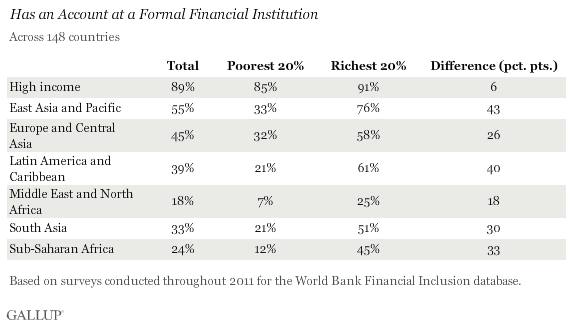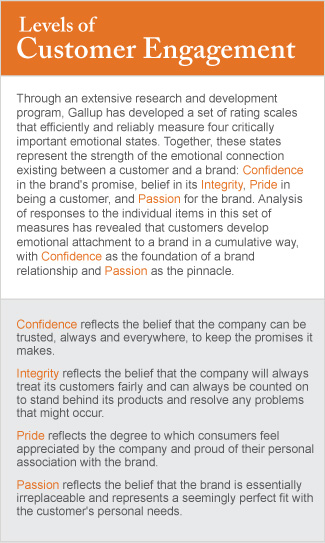Asia's retail banks face a serious problem: Too often, potential customers meet their financial needs through channels other than banks or remain unbanked. For example, about one in 10 Asians took a loan from a financial institution in 2011, but many more -- greater than one-quarter -- chose to borrow from friends or family. And research from the World Bank Global Financial Inclusion (Global Findex) database shows that in East Asia and the Pacific, 55% of the adult population has an account at a financial institution, while in South Asia, only one in three adults has an account.
When banks create the wrong incentives for employees, it has a negative effect on customers.

Developing countries in Asia are expected to grow at a rate of at least 7% annually by 2017, offering a significant opportunity for Asia's retail banks. But lack of trust is a notable barrier for banks in their efforts to capitalize on this burgeoning economic growth.
Bank leaders who seek a market advantage in the Asia-Pacific region should capitalize on opportunities to build trust and deepen customer relationships. Achieving this goal, however, will require bank executives to find the right employee incentives, promote the right employee behaviors, and hire the right talent.
Creating the right employee incentives
Incentives can be a powerful way to encourage and reward employee behavior. But when banks create the wrong incentives for employees, it has a negative effect on customers. And taken to extremes, poorly designed compensation schemes can destabilize an entire financial system. The UK Financial Services Authority recently launched an initiative to outlaw such flawed sales bonuses for precisely this reason. Short-sighted and self-serving incentives erode trust between customers and their banks because customers suspect -- and often rightly so -- that their banker's advice is not in their best interests.
The problem with these incentive schemes is that they reward employees for serving the bank's needs, not the customers'. As a result, staff members try every possible way to hit their numbers, often at the expense of customer service. The solution is to take a different approach:
-
First, decide on a measure of trust and customer engagement that is robustly linked to desired business outcomes, such as cross-sell ratios and profitability per customer.
-
Next, identify and define the customer service behaviors that drive these outcomes.
-
Finally, provide incentives for staff based on how well they demonstrate those behaviors. Examples include recognizing or rewarding employees who go out of their way to meet customers' needs and who greet customers within 10 seconds of customers entering a branch.
Instilling the right behaviors
Banks make two mistakes that encourage employees to behave in ways that are not customer-centric. First, overly prescriptive standard operating procedures and mystery shopping processes may fail to empower staff to do what is right for the customer. For example, call center staff members are trained to mechanically ask, "Is there anything more I can help you with today?" at the end of each call, even when they failed to help the customer solve his or her problem.
Second, many bankers believe that creating detailed job descriptions for each role is enough to help employees understand how to perform their role and how to interact with customers. This is clearly not the case. Gallup's research with 11 of Asia's finance and insurance companies shows that only four in 10 employees strongly agreed with the statement "I know what is expected of me at work."
Correcting these problems requires banks to intensify their training and communication. Staff members should not only understand their bank's processes and procedures but also the key behaviors that encourage trust and customer engagement. Communication from leaders about building customer trust must go beyond lip service and a relentless focus on financial results. To build trust, customer-centricity must be at the core of the bank's mission. Clear communication will help employees understand and exhibit behaviors that build it.
Hiring the right talent
The best way for banks to ensure that their employees exhibit the right behaviors is to hire people with the right talent for their role. Gallup defines a talent as a naturally recurring thought, feeling, or behavior that can be productively applied. However, academic qualifications or prior experience are often used as a proxy for ability and weighted favorably in the hiring process.
Instead, banks need an objective way to select employees who are naturally inclined to meet customers' needs while also helping the bank achieve its financial goals. Talent-based selection and career planning is still rare in Asia's banks, yet there is strong evidence that talent-based selection works. A Gallup client using this disciplined strategy, for example, has seen a 64% profit lift over four years -- and a 184% increase over an eight-year period -- in one of its businesses.
Once hired, employees need support from great managers who are naturally inclined to want to help them succeed. Far too many organizations -- banks included -- promote outstanding salespeople into management roles without considering whether they have the right talents to succeed as a manager. The result of this strategy ensures manager incompetence, because the talents required to be a great salesperson aren't necessarily the talents required to be a great manager.

Career tracks should provide ways for employees to grow within their roles (horizontal success) or into new roles if they have the right talent to succeed in those roles (vertical success). This approach provides opportunities to recognize spectacular individual contributors appropriately and in a different way than employees with executive potential. Building this kind of "talent machine" should be deliberate and based on solid research into what it takes to be successful in any role, whether as an individual contributor or as a manager. This approach can help embed the necessary talent into a bank that's required to build its brand on customer engagement and trust.
The bottom line
Executives at Asia's retail banks need to confront the uncomfortable reality that for customers, "feelings are facts." Gallup analysis shows that customers who are classified as fully engaged represent a 23% premium in share of wallet, profitability, revenue, and relationship growth, while actively disengaged customers represent a 13% discount on the same measures.
Creating fully engaged customers requires inspiring high degrees of Confidence, Integrity, Pride, and Passion. Failure to do this gives banking customers little reason to consolidate their increasingly fragmented banking relationships. To reverse this trend, banks must rethink their understanding of employee behavior and refocus their organizations on building trust and customer engagement.
A version of this article originally appeared in Asian Banking & Finance.